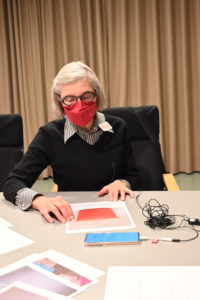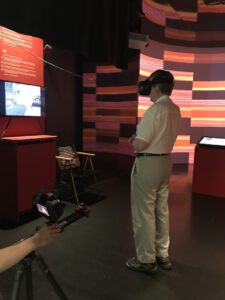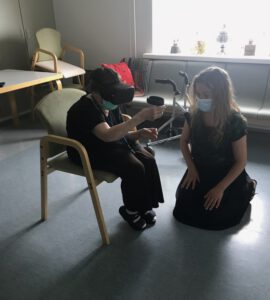The goal of the EU SPICE project is to utilize digital technology to promote social cohesion, participation, and inclusion through engagement with cultural heritage. Funded through the EU Horizon 2020 Research and Innovation Programme, the project involves case studies in five countries, one of which is a collaboration between Aalto University and Design Museum Helsinki. As part of the Finnish pilot, an experimental, interactive VR pop-up museum will be designed around the Design Museum’s collections. The three-year SPICE project was launched in May 2020, with senior citizens as the chief target group of the Finnish pilot. The first workshops are currently in progress, with participants being asked to share their personal experiences of design.
Aalto University and Design Museum Helsinki are collaborating on a pilot as part of the SPICE EU project. What’s the project all about?
Leena Svinhufvud, Head of Learning, Design Museum Helsinki: The SPICE project’s aim is to foster dialogue and provide tools for the public to engage in curatorial practices. Our pilot explores citizen curation as a means of promoting social cohesion. The five case studies launched as part of the SPICE project involve five divergent European museums, ranging from the Irish Museum of Modern Art IMMA to the National Natural History Museum in Madrid. Lily Diaz-Kommonen, Professor of New Media at Aalto University, whose long-term research interests include the development of digital tools for citizen curation of cultural heritage leads and is responsible for the work being carried out in the pilots.
Ours is a trailblazing, “Gyro Gearloose” kind of venture, as we are researching and testing wholly new digital approaches to citizen participation. Through the integration of design, technology, and behavioural sciences, we can gain deeper insights into people’s relationships with cultural heritage – and ideally, our experiments will help us adopt innovative new curatorial practices. We will be collaborating with the four other museums in the SPICE project, as our funding is intended for the joint development of new technology. We aim to compare our digital exhibits and possibly even share them on a joint platform.
The Finnish pilot is a pop-up VR museum that offers a virtual space where people can share views, exchange ideas, and visit virtual exhibits from the Design Museum’s collections. We will then explore the VR experience together with our pilot participants. A selection of exhibits from our collections is currently being digitized at Aalto University. A virtual interface is currently being finalized by doctoral candidate Gautam Vishwanath and MA fellow Jiaxin Tao from the Aalto Systems of Representation Research Group, led by professor Diaz-Kommonen.
What is Design Museum Helsinki’s role in the project?
LS: We want to share our expertise in media literacy and digital educational curation, and we also want to offer a platform for dialogue on design heritage. We are interested in hearing about people’s personal connections with iconic Finnish designs such as the Jopo bicycle or the Myrna coffee cup – what are their experiences, and what stories can they share? It will be especially interesting to see what happens when people visit our pop-up VR museum and hear other people’s stories: What memories and experiences might this bring back for others? Design objects are more than just commodities – they play a complex, many-layered role in people’s lives.
We at the Design Museum are also interested in exploring new VR approaches to accessing design exhibits and new ways in which our museum can document information shared by the public. I see this project as marking a step away from a “top-down” approach, with citizens playing a more active role in knowledge building at our museum going forward.
Who are the key target groups?
LS: They vary, the key target group of the Italian pilot is for instance the deaf community, especially teens. Our Finnish pilot focuses on senior citizens, who are often viewed as a challenging group, but we wish to emphasize that this is a highly heterogeneous group with varied competencies. According to a recent Finnish study, only a small proportion of the Finnish elderly population never use digital services, the estimate being 25-34 per cent.
Our second target group consists of migrants and asylum seekers. We are interested in seeing how they respond to design objects with no prior personal relevance for them. What can you say about an object like the classic Moomin mug to someone who has never seen one before?
Our third target group are remote dwellers who live in outlying rural communities. This group is highly relevant in sparsely populated nations such as Finland. People living in rural regions must often travel long distances to access services. Furthermore, research shows that there are even many families residing in the Helsinki metropolitan region who never visit the downtown area or use cultural services. We want to explore whether digital tools might help to remove physical barriers, shorten distances, and bring people together. We intend to also test our pop-up VR museum outside the metropolitan region.
What kind of virtual experience are you currently creating for the new pop-up VR museum? Your background is in game design – how is this reflected in the current pilot?
Gautam Vishwanath, doctoral candidate, Aalto University School of Arts, Design and Architecture: Game design is also tied to virtual reality. Although my background is in game design, I also work closely with VR. I develop games and game adaptations with the help of virtual reality. My background is in game design, but I work with VR as well, especially creating games and game modifications using virtual reality.
In this particular project, we are creating a pop-up VR museum, which will work with portable VR headsets distributed to senior citizens, asylum seekers and remote dwellers. Through the journey, they will experience Design Museum objects and listen to stories in a gamified manner. There will be several game elements, for example, you could be on a journey, and you would have to overcome obstacles, or there could be some puzzle for you to solve that requires you to use the Design Museum’s artefacts.
Several studies, especially by Jane McGonigal, have shown that adding game elements or game modifications create a sense of motivation and makes the experience livelier. That is what I am trying to achieve also in this process.
You have been working in the area of digital technology and cultural heritage for a long time in several different projects and roles. What are your goals in this specific ongoing SPICE project?
Lily Diaz-Kommonen, Professor of New Media, Aalto University School of Arts, Design and Architecture: We’re developing a successful prototype of the pop-up VR Museum for Design Museum Helsinki which clearly demonstrates the capabilities of digital (immersive) media in Virtual Reality format to bridge gaps and provide cultural and physical access and inclusiveness to design heritage.
What would be the ideal outcome of this project from your viewpoint?
LD-K: The successful merger and consolidation of the different digital technologies being deployed in the project, such as Semantic Web and Virtual Reality, and their application – in combination with design methods to human faculties such as personal interpretation and reflection about heritage – can potentially create new breakthroughs.
Check out the latest updates and subscribe to the English newsletter:
https://spice-h2020.eu/finland/
Interview and article: Reetta Haarajoki
Translations: Silja Kudel
Top image: Milja Nieminen



